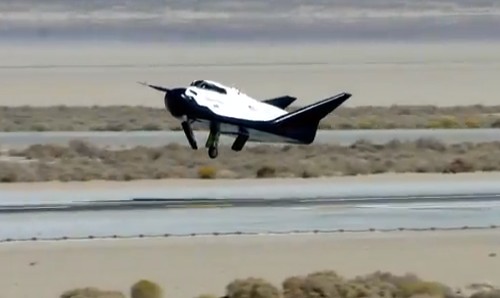
SNC’s Dream Chaser engineering test article (ETA) moments before landing at Edwards Air Force Base on October 26. The image is a still from a video released by the company on October 29; the video cuts off before the actual landing but the missing left main gear is evident in the video. (credit: SNC)
When Sierra Nevada Corporation (SNC) confirmed reports of an “anomaly” during the landing of its Dream Chaser engineering test article (ETA) at the end of its first free flight Saturday, some people assumed the worst, given the lack of details about the incident. On Tuesday, an SNC executive said not only were things not as bad as feared, the flight may actually accelerate the company’s development of Dream Chaser.
“The 99 percent of the flight that we really wanted to test… all that was a 100-percent success,” SNC corporate vice president Mark Sirangelo said in a teleconference with reporters Tuesday morning. He was referring to the phases of the flight leading up to the landing, including the descent and approach to the runway at Edwards Air Force Base in California. “In fact, we probably performed better than the test standards were meant to be. We deem this to be a significant success.”
As Sirangelo recounted to reporters, the flight was going well up until landing. The Dream Chaser ETA was carried aloft to an altitude of 3,800 meters (12,500 feet) by a helicopter and then released. The ETA initially flew at a steep down angle, about 50 degrees, as planned to pick up velocity, then flared up as it approached the runway at Edwards. The automated vehicle aligned itself with the runway’s centerline and descended to landing.
The problem with the left landing gear—the front skid and the right gear deployed normally—appears to be a mechanical issue with the gear. “The commands were given, and the gear was commanded to come down,” Sirangelo said. “The left main gear had a problem and was hung up.” The vehicle tried to compensate for the missing gear upon landing, but eventually skidded off the runway.
The Dream Chaser ETA was damaged, but not seriously. “We believe it to be repairable and flyable,” Sirangelo said. “The entire interior of the vehicle—the pressure vessel, as we call it, or crew compartment—was completely untouched by the incident. All systems were fully operational. There’s no damage whatsoever to any critical components of the vehicle.” SNC is investigating the landing gear failure, he said, adding that the ETA used landing gear taken from an F-5 aircraft and are not the same design that the company would use for later versions of the Dream Chaser.
That said, the company hasn’t said much about exactly what was damaged with the vehicle beyond the fact that no critical components were affected. A six-inch (15-centimeter) protective layer surrounding the composite shell of the vehicle, simulating the thermal protection system the orbital version of Dream Chaser will have, “effectively cushioned” the vehicle as it slid off the runway, Sirangelo said. The company has not released any photos or video of that skid; a video the company released Tuesday cuts off just before landing, although it does show the landing gear deployment and thus the missing left gear. Sirangelo said in an email exchange later Tuesday that he couldn’t say when additional photos or video would be released.
Despite the failed gear, Sirangelo said the flight was still successful enough that it should satisfy the requirements of the test. The test was the final milestone in the company’s Commercial Crew Development 2 (CCDev-2) agreement with NASA; the company is already well on its way through completing the follow-on Commercial Crew Integrated Capability (CCiCap) award. “We believe that we satisfied the requirements” of the CCDev-2 milestone, he said. “NASA needs to review and [is] expected to do that within 30 days.”
Sirangelo emphasized that the key part of the test was testing the flight characteristics of the Dream Chaser and verifying them against models, noting that the test was the first flight of lifting body “of this type” since the 1970s. All of the data to date suggests the vehicle performed as predicted, if not better, which may mean that a second drop test originally planned for the ETA may not be needed.
“This vehicle was only meant to have two autonomous flights anyway before it came back to our headquarters to be reworked for piloted flight, so we’re determining whether or not we actually received enough data from this flight” to skip that second flight and go directly into those modifications, he said.
That decision will be made in a few weeks, he said, adding that if they do decide to skip the second test flight, they will actually be accelerating their testing despite the landing incident. “If we were able to get all the flight data we were expecting to get, we might actually be able to bring the vehicle back earlier and get it ready for its next flight, and that might actually, in some strange way, accelerate the program.”

Leave a Reply